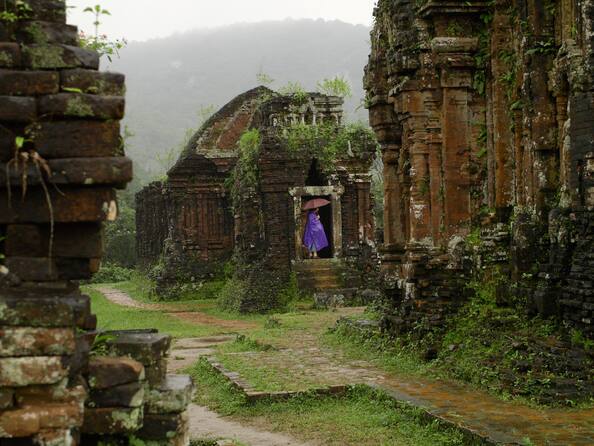圣子修道院
My Son Sanctuary
Between the 4th and 13th centuries a unique culture which owed its spiritual origins to Indian Hinduism developed on the coast of contemporary Viet Nam. This is graphically illustrated by the remains of a series of impressive tower-temples located in a dramatic site that was the religious and political capital of the Champa Kingdom for most of its existence.
La description est disponible sous licence CC-BY-SA IGO 3.0
Sanctuaire de Mi-sön
Du IVe au XIIIe siècle, la côte du Viet Nam contemporain accueillait une culture unique, associée par ses racines spirituelles à l'hindouisme indien. Cette relation est illustrée par les vestiges d'une série d'impressionnantes tours-sanctuaires, au cœur d'un site remarquable qui fut pendant quasiment toute son existence la capitale religieuse et politique du royaume de Champâ.
La description est disponible sous licence CC-BY-SA IGO 3.0
ضريح مي- سون
احتضن ساحل فييتنام الحديثة من القرن الرابع الى القرن الثالث عشر ثقافة فريدة ترتبط جذورها الروحية بالهندوسية الهندية. وتبرز هذه العلاقة في آثار سلسلة من الأبراج الهرمية المدهشة في قلب موقع ملفت شكّل طيلة فترة وجوده تقريباً عاصمة دينية وسياسية لمملكة تشامبا.
source: UNESCO/CPE
La description est disponible sous licence CC-BY-SA IGO 3.0
圣子修道院
公元4世纪到13世纪,一种独特的文化在现在的越南边境地区得到了发展,这种文化的宗教起源是印度教。由占婆王国作为宗教和政治首府时所保存的一系列庙宇和殿堂生动地说明了这一切。
source: UNESCO/CPE
La description est disponible sous licence CC-BY-SA IGO 3.0
Святилище Мишон
В период между IV и XIII вв. в этом приморском районе Вьетнама сложилась уникальная цивилизация, духовные основы которой были тесно связаны с индуизмом. Доказательством этому служат остатки впечатляющих башнеподобных храмов, расположенных в живописном месте, где некогда существовала религиозная и культурная столица государства Чампа.
source: UNESCO/CPE
La description est disponible sous licence CC-BY-SA IGO 3.0
Santuario de My Son
En el litoral del actual Viet Nam floreció, entre los siglos IV y XIII, una civilización única en su género, cuyas raíces espirituales estaban estrechamente vinculadas al hinduismo. Vestigio de esa civilización es el conjunto de imponentes torres-santuarios erigidas en el sitio espectacular donde estuvo emplazada la ciudad que fue capital política y religiosa del Reino de Champa durante la casi totalidad de ese periodo.
source: UNESCO/CPE
La description est disponible sous licence CC-BY-SA IGO 3.0
ミーソン聖域
ベトナム中部、チャンパ王国初期の首都にあたるトラキエウの西方約15kmにある、ヒンドゥー教シヴァ神信仰の聖地。4世紀末に創建のリンガ寺院にはじまり、13世紀までに建てられた寺堂の遺構・遺跡は大小67カ所に及ぶ。最も注目されるのは遺構Aの中心にある煉瓦積みの祠堂で、装飾文様も高度に洗礼され、比較的保存もよく、インドなどからの影響を受けたチャンパ美術の頂点を示している。source: NFUAJ
My Son-heiligdom
Het My Son heiligdom dateert uit de 4e tot 13e eeuw voor Christus. In die periode ontwikkelde zich bij de kust van het hedendaagse Vietnam een unieke cultuur, die zijn spirituele oorsprong vond in het Indisch hindoeïsme. Dit blijkt duidelijk uit de overblijfselen van een reeks indrukwekkende toren-tempels, gelegen in een stad die voor het grootste deel van haar bestaan de religieuze en politieke hoofdstad was van het koninkrijk van Champa. Onder invloed van het Indiaas hindoeïsme werden veel tempels gebouwd om Hindoegoden te eren. Hoewel Mahayana-boeddhisten de Cham-cultuur binnendrong, bleef het hindoeïsme de gevestigde staatsgodsdienst.
Source : unesco.nl
